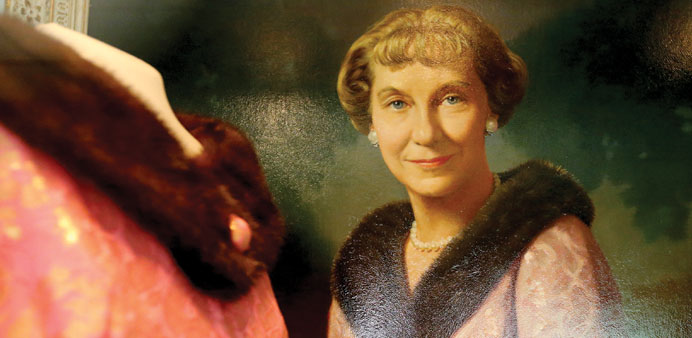By Beccy Tanner
As the United States of America gears up for another presidential election, a trip to Abilene — 90 miles north of Wichita — will give visitors a chance to see how America’s 34th president Dwight D Eisenhower made decisions, lived his life and the legacy he left for future generations. This year marks the 125th year of his birth.
The Dwight D. Eisenhower Presidential Library, Museum and Boyhood Home in Abilene, two miles south of the Abilene exit off I-70, tells the story of how Eisenhower spent much of his boyhood years and offers tours of his home.
The 22-acre complex in a park-like setting attracts more than 200,000 visitors each year — many born long after Eisenhower’s lifetime and who may not understand his prominence in the world, said Tim Rives, deputy director of the Eisenhower Presidential Library, Museum and Boyhood Home.
“Ike was born in the year that the frontier was declared closed and died the year that the United States sent astronauts to the moon,” Rives said. “His life bridged the 19th and 20th centuries. He was supreme commander in a military operation that decided the fate of the western world for half a century, with his decision to invade Normandy on June 6, 1944. He was also president for two terms and maintained peace and prosperity for eight years.
“Civil rights were advanced in the Eisenhower administration, NASA was founded, and the Interstate system was begun, and the Korean War was ended. All of these events, Ike was at the helm.”
What to see
Plan on spending at least two to four hours at the Eisenhower building complex.
Visitors to the Eisenhower Museum can see the electric car that belonged to Ike’s mother-in-law, Elvira Doud, but that Eisenhower frequently drove. They can see his staff car used through World War II and into his presidency; the collection of pearl necklaces and earrings that belonged to his wife, Mamie; the table Eisenhower used to plan strategy as the commander of the D-Day invasion at Normandy, France; and the Order of Victory medal he received from the Union of Soviet Socialist Republics. The museum also has election memorabilia. When Eisenhower ran for election in 1952 on the Republican ticket, “I like Ike” became a household slogan.
The two-story white boyhood home where he lived from 1898 to 1911, when he left for West Point Military Academy, is open for tours. People can see the radio around which the family gathered to hear the news and popular programmes, the piano in the parlour along with family photographs and a Bible showing his birth entry.
Although the library is where the Eisenhower archives are located, visitors can view temporary exhibits on the library’s mezzanine lobby and view a 12-minute video that gives a behind-the-scenes look at what goes on in a research library. The library attracts about 900 researchers a year and 4,000 long-distance reference requests.
The Eisenhower Library is consistently one of the most sought-out presidential libraries for researchers and writers, Rives said.
“If someone wants to do research, they really have to come to Abilene because of the 26 million documents we have and our 300,000 photographs haven’t been digitised yet,” he said. “Someday down the road, yes, once the problems of expense and technology are worked out.”
The Place of Meditation on the campus of the Eisenhower Library and Museum was envisioned by Eisenhower as not his final resting place but as place of meditation and reflection for soldiers. The chapel includes the tombs of Eisenhower, Mamie and their son Doud. In 1962, nationally known stained-glass artist Odell Prather, originally of Wichita, was commissioned to do the windows in the chapel at the Eisenhower Center in Abilene. She was asked to do something abstract so as not to offend a person of any faith. She based her artwork on the Kansas plains.
The centre hopes soon to have interactive signs throughout the campus for visitors who often pull off of I-70 after the complex closes for the night, Rives said. Signs would include information about the Chisholm Trail and how the centre is on Buckeye Avenue, where cattle herds were driven; where the Eisenhowers’ garden and hay fields were located; and other information that helped influence Eisenhower’s life.
Other things to see in abilene
The Greyhound Hall of Fame — This museum devoted to the history of greyhound racing is across the street from the Eisenhower Center. Admission is free.
Seelye Mansion — Tour the 25-room home, garden and museum at 1105 N. Buckeye Ave. Guided tours are 10am to 4pm Mondays through Saturdays and 1 to 4pm Sundays. Cost is $10 for adults, $7.50 for groups of 10 or more and $5 for ages 6 to 16.
Great Plains Theatre — For a chance to see live theatre, consider an evening performance. Productions run through December 20. For more information, go to www.greatplainstheatre.com
Russell Stover Candies and Factory and Store — Located off I-70 at 1993 Caramel Blvd. A stop at the outlet store allows visitors a chance to purchase Russell Stover, Whitmans and Pangburn’s candies.
Brookville Hotel — Located at 105 E. Lafayette. The menu has changed little since the original restaurant began in the town of Brookville in the 1870s. Fried chicken, mashed potatoes, coleslaw, relishes, creamed corn, biscuits and ice cream are on the menu. Cost is $16 for adults, with another $2 for soda, milk, tea and coffee. — The Wichita Eagle/TNS

